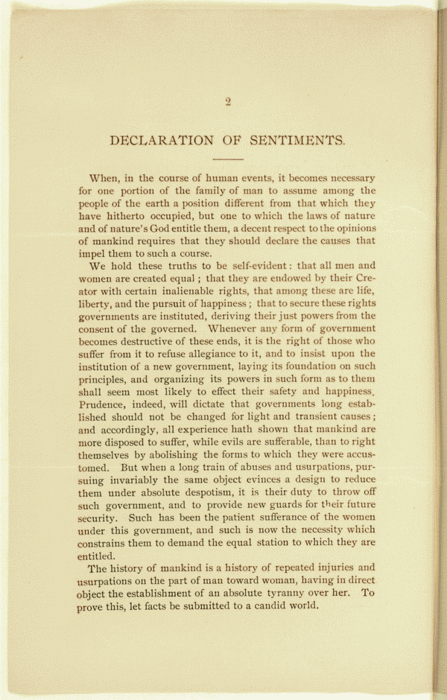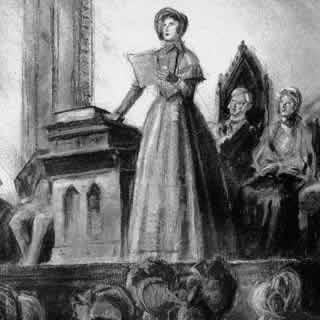The Seneca Falls Convention for Women's Rights
The Seneca Falls Convention was a gathering of Americans from around the country to further the cause of women's rights, including the right to vote (or suffrage). The convention took place on July 19 and July 20, in 1848, in Seneca Falls, N.Y. Two of the leaders of the women's suffrage movement, Elizabeth Cady Stanton and Lucretia Mott, had attended the Anti-Slavery Convention in London in 1840. They and all other women who attended were denied the opportunity to take part in any of the discussions; in fact, the men forced the women to sit behind partitions, as if they weren't there.
Douglass had been a prominent proponent of an extension of rights for both women and African-Americans. Another prominent abolitionist, William Lloyd Garrison, had encouraged women to participate in anti-slavery associations. Mott, Stanton, and other women argued that if white men could advocate for African-Americans to have the vote, then they could advocate for white women to have the vote. (The abolitionist movement was largely built on the assumption that freedom for African-Americans didn't include the freedom for African-American women to vote or to own property.) At any rate, by the 1840s, the abolitionist movement had gained a large number of female adherents, many of whom were also asserting their desire for more rights under the law. The convention took place at the Wesleyan Methodist Chapel, in Seneca Falls. Although the convention organizers had announced that the first session was intended to be exclusively for women, they allowed the attendance of about 40 men and a number of children of both genders. (The men, however, were asked to refrain from commenting on the proceedings.) At the first session, which started at 11 a.m., Stanton and Mott both spoke, with Stanton reading out the entire Declaration of Sentiments. She followed the full reading with a section-by-section repeat performance, with discussions in between on the wording and intent. After a short break to gain some relief from the 90-degree heat, the attendees began the afternoon session, during which more discussion on the Declaration occurred. One of the issues gaining the most attention was women's suffrage. The final session of the day, in the evening, featured a standing-room-only speech delivered by Mott. Both men and women were in attendance. (It was still rare at this time for women to speak in public, especially to an audience that included men.)
The movement didn't stop there, of course. Word spread of the convention, its participants, and the Declaration of Sentiments. Another convention followed, in 1851, in Worcester, Mass. This National Women's Rights Convention was an annual event for the next decade, until the Civil War began. Mott, Stanton, Susan B. Anthony, Lucy Stone, and other women led the women's suffrage movement. The movement got so big at one point and aroused so much passion on both sides that a rift developed between the leaders of the movement. Despite that, progress continued, although it took a lot longer than the movement's leaders would have liked. When the Nineteenth Amendment was passed, in 1920, only one of the women who signed the Declaration of Sentiments, Charlotte Woodward, was still alive. Even though she had the right, she was not well enough to vote herself. |
|
Social Studies for Kids
copyright 2002–2026
David White

 Mott and Stanton weren't too happy with the treatment at what was billed as a world convention. They were also part of a growing number of women who were asserting their dissatisfaction with the current state of affairs. Stanton went away and wrote the Declaration of Sentiments, a document inspired the Declaration of Independence that asserted that women should have many rights currently not allowed to them, including the right to own property and the right to vote. This document was the guiding force behind the six sessions and many other discussions that the 300 men and women participated in during the two-day convention. Among those attending was noted abolitionist (and free African-American)
Mott and Stanton weren't too happy with the treatment at what was billed as a world convention. They were also part of a growing number of women who were asserting their dissatisfaction with the current state of affairs. Stanton went away and wrote the Declaration of Sentiments, a document inspired the Declaration of Independence that asserted that women should have many rights currently not allowed to them, including the right to own property and the right to vote. This document was the guiding force behind the six sessions and many other discussions that the 300 men and women participated in during the two-day convention. Among those attending was noted abolitionist (and free African-American)  The first session on the second day was a repeat of the previous day, with more discussion on the Declaration and an eventual endorsement and signing. Of the 300 people assembled, 100 signed their names, including 32 men. The afternoon session consisted of further discussion on resolutions to go along with the Declaration, including most notably the right of women to vote: "Resolved, that it is the duty of the women of this country to secure to themselves their sacred right to the elective franchise." Speeches by Douglass and Mott rounded out the session. The last session featured a discussion of legal rights, including a reading of several passages from the well-known British legal expert Sir William Blackstone. Mott again gave a rousing speech, and the convention ended. As a final step, the attendees named members of a committee to publish the written record of the proceedings.
The first session on the second day was a repeat of the previous day, with more discussion on the Declaration and an eventual endorsement and signing. Of the 300 people assembled, 100 signed their names, including 32 men. The afternoon session consisted of further discussion on resolutions to go along with the Declaration, including most notably the right of women to vote: "Resolved, that it is the duty of the women of this country to secure to themselves their sacred right to the elective franchise." Speeches by Douglass and Mott rounded out the session. The last session featured a discussion of legal rights, including a reading of several passages from the well-known British legal expert Sir William Blackstone. Mott again gave a rousing speech, and the convention ended. As a final step, the attendees named members of a committee to publish the written record of the proceedings.
